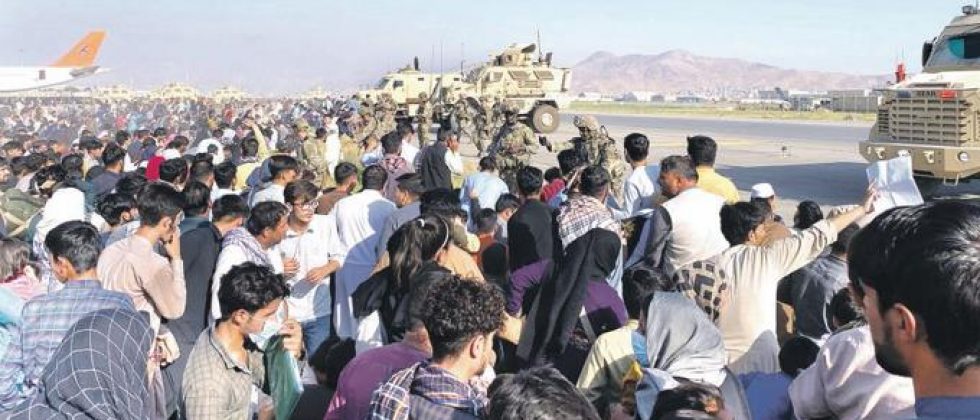news
“20 Years Later: The Failure of the United States in Afghanistan”, an article by Dr. Leonel Fernández
August 22, 2021
In yesterday´s edition, dated Sunday, August 22, The New York Times published a long and detailed account the U.S. has played in Afghanistan, and also highlights the various mistakes made in the recent withdrawal process of US troops and diplomatic personnel from that nation.
And rightly so. The withdrawal process has been chaotic. The images captured at the Kabul Airport, the Afghan capital, reveal a state of panic, anguish and exasperation. The reasons given for this chaotic situation have highlighted a lack of coordination between the State Department, the Pentagon, other intelligence agencies, and the White House.
It is possible that the reasons that have been given are legitimate, but the failure has not only been in the withdrawal of US military troops and civilian personnel along with their Afghan allies. Of greater importance has been the inability to achieve several of the strategic objectives that were designed to carry out the military occupation during the past 20 years, and which began in 2001.
After the terrorist attacks against the twin towers of the World Trade Center and the Pentagon, on September 11, 2001, the government of President George W. Bush responded – with the support of the United Nations Security Council – by organizing a coalition of countries and ordering the war against Afghanistan.
That war, in principle, was received with sympathy in different parts of the world, due to the outrage felt due to the terrorist attacks carried out by the al Qaeda group, led by Osama Bin Laden, and which killed more than three thousand individuals.
With remarkable speed, the Taliban – a political, military and religious Sunni Islamist organization that supported Bin Laden’s terrorist movement – were ousted from power. Many considered this strategy as a highly successful operation.
In general terms, comparisons have been made between the wars in Afghanistan and Iraq, which began two years later in 2003. However, this time around and without the support of the United Nations, the U.S. government made the unilateral decision to have the US army occupy the territory that was once known as ancient Mesopotamia to overthrow the Saddam Hussein regime. He was accused of storing weapons of mass destruction in his country.
This second war front in Iraq, found no support within the international community. The main argument was that these arguments have nothing to do with the terrorist acts of September 11. However, the situation produced a distraction from the original strategic goals in Afghanistan.
Goals in Afghanistan
In addition to the objective of ousting the Taliban from power, dismantling the al Qaeda terrorist group and executing Osama Bin Laden, the United States – with its occupation of Afghanistan – worked to apply a counterinsurgency strategy that would promote the values of Western democracy and carry out a process that would lead to the physical, economic and social reconstruction of the country.
This overall strategic vision was carried out with the goal of preventing the repetition in the future of the conditions that would discourage other terrorist organizations, such as al Qaeda or Daesh, to use Afghan territory to plan and undertake new acts of violence against the United States or any other western nation.
However, the counterinsurgency tactics did not work well. The Taliban, after being ousted from power, took refuge in neighboring Pakistan where they received economic, political and military support.
They managed to survive. They proved to be resilient. Over time, they began to regroup and grow. They took advantage of the discontent generated by incompetent, insensitive and corrupt governments, which were also perceived to have been imposed by a foreign occupation.
The US authorities excluded the Taliban from the political process, leaving only a military confrontation as an option. After almost 20 years of occupation, the overall consensus was that a military success was not possible. Due to this scenario, the powers involved in the conflict tried to negotiate with this group the eventual withdrawal of the US troops stationed in that Asian nation.
That was the Doha agreement, initially promoted by President Donald Trump in February 2020, and followed through by current President Joe Biden, who had set the goal of withdrawing the troops from the country before the 20th anniversary of the 2001 terrorist attacks.
But, when a peace agreement was negotiated in Doha that ended up becoming a troop withdrawal agreement, the Afghan government, the collaborators of the occupation forces and members of the military corps felt totally demoralized.
They all felt abandoned by the United States. The Taliban, realizing that there was already a predetermined period to begin the withdrawal of US troops, implemented a strategy to gradually conquer territories, province by province.
In US intelligence and military strategy analysis sectors it was considered – as early as March of this year – that an eventual take over by the Taliban would take between two and three years. Therefore, they considered that a political and military collapse was not imminent.
However, events have overwhelmed their expectations. The Taliban entered Kabul. Afghan President Ashraf Ghani fled and now, in the Pentagon, everyone is staring at one another pointing fingers.
What will happen?
For the United States, the main objective of the occupation of Afghanistan was to prevent the organization of new terrorist attacks against its territory. This has not occurred during the past 20 years, so in the long run this could be considered a successful strategy.
Until now, the Taliban have been moderate in their use of power. They have not exercised their power based on violence. There have been no mass executions or barbaric acts, as occurred in the past.
It is possible that their leaders are aware that the economic dynamics and the growth experienced during the last two decades could be put at risk with policies that would bring sanctions and isolation from the Western powers in case a systematic violation of human rights policy takes place.
What is evident, as a consequence of the political control of the Taliban, is that there is a new geopolitical reality in the region. The leaders of the People’s Republic of China have had a rapprochement with the new Taliban government. They have expressed their willingness to collaborate in diplomatic, political and commercial relations.
Similarly, Russia has also shown its willingness to recognize the Taliban government. Among other reasons, it is using the current situation as a spearhead in its shaky relations with the United States. It is also protecting itself from the expansion of Muslim radicalism in the Central Asian republics, which were once part of the former Soviet Union.
For such nations as Pakistan, Iran and Turkey, the ascent of the Taliban to power represents a political asset, insofar as it brings a new ally to their cause of international confrontation with the US.
In any case, what is unquestionable is that by anticipating and announcing the departure of the US and NATO troops from Afghan soil they put their adversaries on alert and chaotically precipitated a withdrawal that has launched, on a worldwide scale, a feeling of failure and defeat to the main military power in the world.
However, it has been argued that the U.S. occupation – and its subsequent withdrawal 20 years later – was not a failure.
In the meantime, the Taliban celebrates it as a victory.






